Caryn
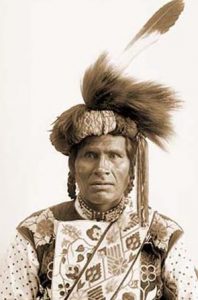 Many people think of the Indians as, well…simply the Indians, whether we intend to or not. I suppose that if we studied the different tribes, their noticeable differences would become very apparent, but if we don’t it’s not so easy to tell them apart. One of the lesser known tribes, at least early on in American history, was the Chippewa tribe. Speculation is that they were already settled in a large village at La Pointe, Wisconsin at about the time that America was discovered. Then, in the early 17th century, they abandoned this area. Many of them returning to their homeland in Sault Sainte Marie, Michigan, while others settled at the west end of Lake Superior, where they were found by Father Claude Jean Allouez, a Jesuit missionary and French explorer, in 1865.
Many people think of the Indians as, well…simply the Indians, whether we intend to or not. I suppose that if we studied the different tribes, their noticeable differences would become very apparent, but if we don’t it’s not so easy to tell them apart. One of the lesser known tribes, at least early on in American history, was the Chippewa tribe. Speculation is that they were already settled in a large village at La Pointe, Wisconsin at about the time that America was discovered. Then, in the early 17th century, they abandoned this area. Many of them returning to their homeland in Sault Sainte Marie, Michigan, while others settled at the west end of Lake Superior, where they were found by Father Claude Jean Allouez, a Jesuit missionary and French explorer, in 1865.
The Chippewa, also known as the Ojibway, Ojibwe, and Anishinaabe, are one of the largest and most powerful nations, having nearly 150 different bands located primarily in Minnesota, Wisconsin, Michigan, and southern Canada…especially Ontario, Manitoba and Saskatchewan. Ojibway means “to roast till puckered up.” It’s an odd name that referred to the puckered seam on their moccasins. Formerly, the tribe lived along both shores of Lakes Huron and Superior, extending across the Minnesota Turtle Mountains and North Dakota. They were strong in numbers and occupied an large territory, but the Chippewa were never prominent in history, mainly because of their remoteness from the frontier during the period of the colonial wars. They were part of an Algonquian group, including the Ottawa and Potawatomi, which divided when it reached Mackinaw in its westward movement.
Sault Saint Marie was their main headquarters about 1640, as mentioned by Jean Nicolet de Belleborne, a French-Canadian woodsman, who called them Baouichtigouin, meaning “people of the Sault”. In 1642, they 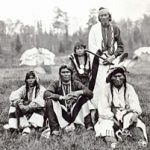 were visited by missionaries Charles Raymbaut and Isaac Jogues, who found them at the Sault and at war with a people to the west, who were probably the Sioux. Because they kept to themselves, away from the frontier, the Chippewa took a very small part in the early colonial wars, but the southern division of the tribe was known to be of warlike disposition. Those to the north of Lake Superior were considered to be peaceful. They were termed by their southern brothers as “the rabbits.” In the north, the members of the tribe were described as the “men of the thick woods” and the “swamp people,” terms used to designate the nature of the country they lived in.
were visited by missionaries Charles Raymbaut and Isaac Jogues, who found them at the Sault and at war with a people to the west, who were probably the Sioux. Because they kept to themselves, away from the frontier, the Chippewa took a very small part in the early colonial wars, but the southern division of the tribe was known to be of warlike disposition. Those to the north of Lake Superior were considered to be peaceful. They were termed by their southern brothers as “the rabbits.” In the north, the members of the tribe were described as the “men of the thick woods” and the “swamp people,” terms used to designate the nature of the country they lived in.
The Chippewa people living south of Lake Superior in the late 1600s were fishermen and hunters. They also grew corn and wild rice. Their possession of wild-rice fields was one of the chief causes of their wars with the Dakota, Fox, and other nations. At about this time, they came into possession of firearms, and began pushing their way westward, in a mixture at peace and war with the Sioux but in almost constant conflict with the Fox tribe. The French, in 1692, reestablished a trading post at Shaugawaumikong, now La Pointe Island, Wisconsin, which became an important Chippewa settlement. In the beginning of the 18th century the Chippewa succeeded in driving the Fox, already reduced by war with the French, from north Wisconsin, compelling them to take refuge with the Sac.
The Chippewa took part with the other tribes of the northwest in all the wars against the frontier settlements to 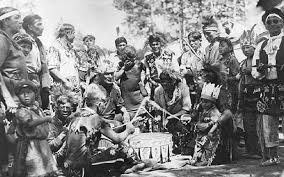 the close of the war of 1812. Those living within the United States made a treaty with the Government in 1815, and afterwards remained peaceful, residing on reservations or allotted lands within their original territory in Michigan, Wisconsin, Minnesota, and North Dakota. By 1900, the Chippewa were estimated to number about 30,000. Today, the collective bands of Chippewa or Ojibwe, are one of the largest groups of Native American People on the North American continent. There are communities in both Canada and the United States. In Canada, they are the second largest population among First Nations, surpassed only by the Cree. In the United States, they have the fourth largest population among Native American tribes, surpassed only by the Navajo, Cherokee and Lakota Sioux.
the close of the war of 1812. Those living within the United States made a treaty with the Government in 1815, and afterwards remained peaceful, residing on reservations or allotted lands within their original territory in Michigan, Wisconsin, Minnesota, and North Dakota. By 1900, the Chippewa were estimated to number about 30,000. Today, the collective bands of Chippewa or Ojibwe, are one of the largest groups of Native American People on the North American continent. There are communities in both Canada and the United States. In Canada, they are the second largest population among First Nations, surpassed only by the Cree. In the United States, they have the fourth largest population among Native American tribes, surpassed only by the Navajo, Cherokee and Lakota Sioux.
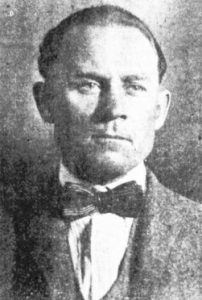 The Spencer ancestry is riddled with names that have been passed down from generation to generation. So much so, in fact, that it can get confusing when researching one’s ancestry. Common names are William, Robert, Thomas, John, Allen, and Christopher. My dad’s family was no different than any other of the Spencer families. The boys in the family were William, named after his grandfather, William, who had a great grandfather named William, and many more I’m sure. My dad was Allen, who was named after his dad Allen, who was named after his grandfather Allen. And many of the children also used those same names, so there were cousins named William and Allen too. Most of the time it only created problems with the ancestry, mail, school things, and such, but when a man named Ethan Allen Spencer (relation, I’m sure, but just how I don’t know) decided that he needed a little bit of excitement in his life, he decided to go from a law-abiding farm family background to becoming a bank and train robber. Ethan Allen “Al” Spencer was born the day after Christmas in 1887 near Lenepah in Nowata County. He came from a law-abiding farm family. He married and soon was the father of a baby girl. So, why would he abandon all that to become a criminal.
The Spencer ancestry is riddled with names that have been passed down from generation to generation. So much so, in fact, that it can get confusing when researching one’s ancestry. Common names are William, Robert, Thomas, John, Allen, and Christopher. My dad’s family was no different than any other of the Spencer families. The boys in the family were William, named after his grandfather, William, who had a great grandfather named William, and many more I’m sure. My dad was Allen, who was named after his dad Allen, who was named after his grandfather Allen. And many of the children also used those same names, so there were cousins named William and Allen too. Most of the time it only created problems with the ancestry, mail, school things, and such, but when a man named Ethan Allen Spencer (relation, I’m sure, but just how I don’t know) decided that he needed a little bit of excitement in his life, he decided to go from a law-abiding farm family background to becoming a bank and train robber. Ethan Allen “Al” Spencer was born the day after Christmas in 1887 near Lenepah in Nowata County. He came from a law-abiding farm family. He married and soon was the father of a baby girl. So, why would he abandon all that to become a criminal.
“Al” Spencer became a criminal as the era of horseback riding was coming to an end, and modern motorized criminals were just getting started. That fact, made Spencer an almost forgotten outlaw. Spencer began his career in crime by getting caught stealing cattle in his early 30s. Then in 1919, he and two men burglarized a clothing store in Neodesha, Kansas. Detectives recovered most of the stolen property and arrested Spencer in La Junta, Colorado. The Kansas court convicted and sentenced him to five years in prison. Then the Oklahoma authorities gained custody of Spencer so they could try him on charges of cattle theft. Spencer pleaded guilty and was sentenced to three to 10 years in the Oklahoma penitentiary at McAlester. He began serving his sentence in March 1920. If you ask me, he should have stuck to farming, because he wasn’t very good at crime. Spencer became friends with another convict named Henry Wells and learned a great deal about crime…becoming better, I suppose…at least as long has Wells was with him. In the 1920s, it was not unusual for Oklahoma governors to grant convicts a leave of absence from prison…even some convicted of major crimes. Spencer was given leave on July 26, 1921, to attend to “some family business” supposedly. He returned to McAlester a month later and became a trustee and was trained to be an electrician. Early in 1922, he was assigned to do electrical work outside the prison in someone’s home. He completed the work, but then he packed up his tools and didn’t return to the prison.
Within a month, Spencer had hooked up with Silas Meigs, who had escaped in a similar fashion from the prison. The pair robbed the American National Bank at Pawhuska, making a “major” haul of $147. Soon the two men robbed a bank at Broken Bow, and this one netted a little more profit. They escaped with between $7,000 and $8,500. They forced a motorist to take them three miles north of town where they had left two horses. The robbers rode away. A few days later Meigs was killed in a gun battle with lawmen northwest of Bartlesville, where he had gone to visit his brother. Spencer remained hidden in the Osage Hills, a vast stretch of country with timber, rocky canyons and thickets of almost impenetrable scrub oak. Friends and relatives brought him food. Spencer later joined up with Henry Wells and two other criminals and robbed a bank at Pineville in 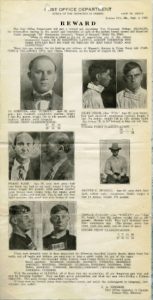 southwest Missouri. Spencer soon hopped a freight train bound for Oklahoma. Spencer found three other men to help him burglarize a store in Ochelata south of Bartlesville. They were surprised by the town’s night marshal who was shot and killed before the outlaws fled in a car. On June 16, Spencer and another man robbed the Elgin State Bank in Chautauqua County, Kansas. They fled with about $2,000 in cash and $20,000 in bonds.
southwest Missouri. Spencer soon hopped a freight train bound for Oklahoma. Spencer found three other men to help him burglarize a store in Ochelata south of Bartlesville. They were surprised by the town’s night marshal who was shot and killed before the outlaws fled in a car. On June 16, Spencer and another man robbed the Elgin State Bank in Chautauqua County, Kansas. They fled with about $2,000 in cash and $20,000 in bonds.
Exactly how many banks were robbed by Ethan Allen “Al” Spencer during the eighteen months following his escape is not known. Evidence suggests he probably robbed at least 20 banks in Oklahoma, Kansas, Missouri and Arkansas. The end of his crime spree came on a Saturday evening, September 15, 1923, when he was shot and killed. There is, however, debate on just how he was killed. U.S. Marshal Alva McDonald, a veteran lawman and personal friend of Teddy Roosevelt, claimed he and other lawmen shot Spencer just south of Caney, Kansas. Another account reported that Spencer was killed about five miles north of Coffeyville, Kansas. The third account came from outlaw Henry Wells’ autobiography. Wells claims that Stanley Snyder, a friend of Spencer’s, killed the outlaw with a shotgun while Spencer was eating supper. Some friend he must have been, but then I guess there is no honor among thieves. Al Spencer’s outlaw days were over, nevertheless, and a new breed of bad men soon took his place using only automobiles. Spencer was the last major Oklahoma outlaw to use horses in his crimes.
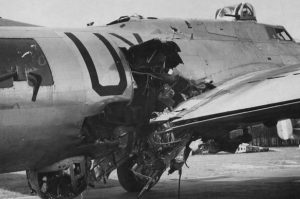
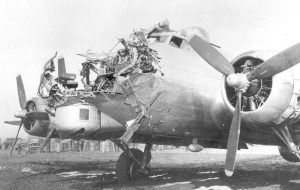 My dad was the top turret gunner and flight engineer on a B-17G Fortress Heavy Bomber during World War II. That was something that my family always knew. Dad didn’t talk much about it, but we were always very proud of him. What we didn’t know about all of that was that my dad was on the toughest plane ever built. At the time of his service, this little known fact probably wouldn’t have brought much comfort to his parents or siblings, but now, all these years later, it somehow brings a good measure of comfort to my dad’s daughter…me. My dad made it home from the war, of course. I know that there were times that his plane sustained damage, but it always brought the crew home.
My dad was the top turret gunner and flight engineer on a B-17G Fortress Heavy Bomber during World War II. That was something that my family always knew. Dad didn’t talk much about it, but we were always very proud of him. What we didn’t know about all of that was that my dad was on the toughest plane ever built. At the time of his service, this little known fact probably wouldn’t have brought much comfort to his parents or siblings, but now, all these years later, it somehow brings a good measure of comfort to my dad’s daughter…me. My dad made it home from the war, of course. I know that there were times that his plane sustained damage, but it always brought the crew home.
The testing of the B-17 Bomber, as is the case with most planes was rigorous. Is this great trial, the B-17 Flying Fortress put up one of most impressive displays, proving not only an effective carrier of firepower in which the plane delivered over a 3rd of the ordnance dropped by the allies in Europe and much of the ordnance dropped in the Pacific, but an astoundingly tough plane. Pilots and crews soon learned that the B-17s, which flew tens of thousands of missions under heavy anti-aircraft and fighter-plane pressure, could take extraordinary damage and still get home.
During the war years, the B-17s proved time and time again just what a wonderful plane they were. While they may not have brought their entire crew home every time they returned, they came home with part of them even with parts of the nose, propellers, and wings missing…and even with a tail that was hanging on by a thread. Of course, if the wing was torn completely off or the plane took a hit that ripped it in half, it did go down, but that is to be expected, as was the case with B-17G-15-BO “Wee Willie,” 322d BS, 91st BG, after direct flak hit on her 128th mission.
Still, the condition in which some of these planes came home would have shocked the builder altogether, if you ask me. I have looked at the pictures of these damaged planes, and I don’t know how they stayed in flight. The 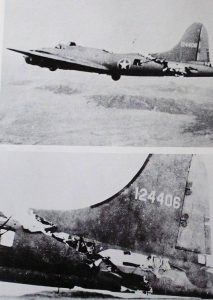
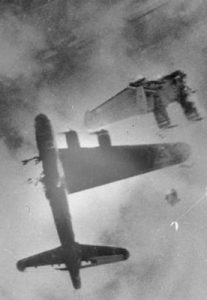 “All American,” with the 97th Bomber Group, made without a doubt, the most astonishing return. The plane had a huge gash in it’s tail section from a collision with an enemy fighter, whose wing sliced almost completely through the fuselage. The tail gunner was trapped at the rear of the plane because the floor connecting his section to the rest of the plane was gone. The plane was piloted by Lieutenant Kendrick Bragg, who flew 90 minutes back to base with the tail barely hanging on. One crew member said that the tail wagged like a dog’s tail. The pilot, proceeded to drop his bombs, and then made a U-turn taking the plane in a wide turn over 70 miles, so as not to stress the tail. When the plane landed and came to a complete stop, the tail finally broke off. Now that is one tough plane!!
“All American,” with the 97th Bomber Group, made without a doubt, the most astonishing return. The plane had a huge gash in it’s tail section from a collision with an enemy fighter, whose wing sliced almost completely through the fuselage. The tail gunner was trapped at the rear of the plane because the floor connecting his section to the rest of the plane was gone. The plane was piloted by Lieutenant Kendrick Bragg, who flew 90 minutes back to base with the tail barely hanging on. One crew member said that the tail wagged like a dog’s tail. The pilot, proceeded to drop his bombs, and then made a U-turn taking the plane in a wide turn over 70 miles, so as not to stress the tail. When the plane landed and came to a complete stop, the tail finally broke off. Now that is one tough plane!!
 Wyoming has just two escalators, and they are both located in Casper. One is at Hilltop National Bank, and the other is at First Interstate Bank, in the historic part of Casper, the downtown district. My connection is to the escalator at First Interstate Bank, which was First National Bank then. The building that the bank occupies is located at 104 South Wolcott Street. Construction began in in 1956, the year I was born. According to a write up on nps.gov, “That building opened in June 1958. A pamphlet published by the First National Bank of Casper around 1959 stated: “The dream of the directors began to take shape in 1953, when Architect Robert Wehrli presented preliminary plans for the bank and tower building that was to rise at First and Wolcott…” At the time of its completion it was the tallest building in the state and featured the state’s first escalator. Drive-through windows and two levels of underground parking were introduced in the early 1960s.”
Wyoming has just two escalators, and they are both located in Casper. One is at Hilltop National Bank, and the other is at First Interstate Bank, in the historic part of Casper, the downtown district. My connection is to the escalator at First Interstate Bank, which was First National Bank then. The building that the bank occupies is located at 104 South Wolcott Street. Construction began in in 1956, the year I was born. According to a write up on nps.gov, “That building opened in June 1958. A pamphlet published by the First National Bank of Casper around 1959 stated: “The dream of the directors began to take shape in 1953, when Architect Robert Wehrli presented preliminary plans for the bank and tower building that was to rise at First and Wolcott…” At the time of its completion it was the tallest building in the state and featured the state’s first escalator. Drive-through windows and two levels of underground parking were introduced in the early 1960s.”
So, I’m sure you are wondering what that information and that building could possibly have to do with me. Well, with the pamphlet came a public invitation to tour the new bank at their open house. My mother, Collene Spencer decided to go and take her three daughters with her, my older sister, Cheryl, who was 5 then; my younger sister, Caryl, who was a baby; and her 3 year old  daughter…me. The open house was very cool, and there were a lot of people there. We toured every floor, and found it all to be interesting and sparkling with newness. Of course, the highlight of the whole bank was the escalator. It was the first one in the state and everyone wanted to see it, and have a ride…and we were no different.
daughter…me. The open house was very cool, and there were a lot of people there. We toured every floor, and found it all to be interesting and sparkling with newness. Of course, the highlight of the whole bank was the escalator. It was the first one in the state and everyone wanted to see it, and have a ride…and we were no different.
As we prepared to leave, my mom assisted me into the escalator, and then turned for my sister, Cheryl, who had stepped aside to look at something. By the time Mom got Cheryl on the escalator, I was a couple of people ahead of them. It had only taken a couple of seconds really. Nevertheless, my place in historic downtown Casper was sealed. As I approached the bottom, the older woman in front of me wasn’t sure just how to get off. In her momentary panic, she started backstepping. At 3 years of age, I had no idea how to do that, and so when my feet hit hers, it pushed her off of the escalator, and I fell. My screams could be heard all over the 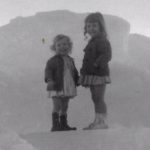 bank. My frilly dress became entangled in the sharp teeth of the escalator’s steps as they cut my elbow and chin. With that incident, while few people ever knew about it, and you would not read about it in any historical accounts, I became the first person injured on the first escalator in Wyoming. The bank president came running over, promising to pay for medical bills and a new dress, while begging my mother not to sue the bank. Of course, back then things were different, and a lawsuit was the last thing on my mother’s mind. For me, while I was only 3, the picture of that woman backstepping on the escalator steps has always remained clear and vivid in my memory files, and the scars on chin and elbow remain too. While I can use escalators, I still get a pain in the pit of my stomach every time I get on or off.
bank. My frilly dress became entangled in the sharp teeth of the escalator’s steps as they cut my elbow and chin. With that incident, while few people ever knew about it, and you would not read about it in any historical accounts, I became the first person injured on the first escalator in Wyoming. The bank president came running over, promising to pay for medical bills and a new dress, while begging my mother not to sue the bank. Of course, back then things were different, and a lawsuit was the last thing on my mother’s mind. For me, while I was only 3, the picture of that woman backstepping on the escalator steps has always remained clear and vivid in my memory files, and the scars on chin and elbow remain too. While I can use escalators, I still get a pain in the pit of my stomach every time I get on or off.
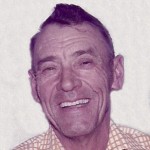 When I married into the Schulenberg family, I had no idea what the future would bring…we really never do. I just knew I was in love with my husband, Bob, and I liked his family very much too. Bob’s dad, Walt Schulenberg was quite a character, with a flair for teasing and joking with those people he liked. I liked him very much. In many ways, he was like my own dad, Al Spencer, and very much like my husband. They all loved to tease the “pretty girls,” as they would say, and it endeared them to every one of those girls too. Early on my father-in-law let me know what life in the Schulenberg family was going to be like. The first time I met him, he started teasing, and I sent much of the time red face, but not upset, because was used to it after all. My father-in-law was a happy man, and he liked to see the positive things in life. He had a great smile, and he wasn’t afraid to use it. Anyone who knew him, would tell you he was truly an amazing man.
When I married into the Schulenberg family, I had no idea what the future would bring…we really never do. I just knew I was in love with my husband, Bob, and I liked his family very much too. Bob’s dad, Walt Schulenberg was quite a character, with a flair for teasing and joking with those people he liked. I liked him very much. In many ways, he was like my own dad, Al Spencer, and very much like my husband. They all loved to tease the “pretty girls,” as they would say, and it endeared them to every one of those girls too. Early on my father-in-law let me know what life in the Schulenberg family was going to be like. The first time I met him, he started teasing, and I sent much of the time red face, but not upset, because was used to it after all. My father-in-law was a happy man, and he liked to see the positive things in life. He had a great smile, and he wasn’t afraid to use it. Anyone who knew him, would tell you he was truly an amazing man.
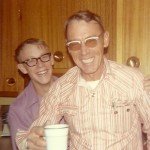
My father-in-law, who quickly became Dad, and the second great father figure in my life, was a hard working man…almost a workaholic, except that as important as his family was to him, he made sure to spend good quality time with all of us too. He loved my mother-in-law, Joann with all his heart, and his kids and grandkids a very close second. When his kids were young, he learned the value of spending time with family, when he was working out of town, and his daughter Brenda didn’t know him. That was it. He got a job closer to home. He loved being a grandpa and great grandpa, and I wish he could have been here to be a great great grandpa. He loved to make things for the kids, and they all loved the things he made.
He could make or build just about anything he put his mind to…from wooden toys and spinners, to a garage, 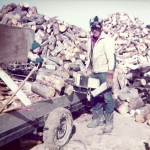 and even a house. He was a mechanic by trade (among other things), and he could fix just about anything. It was a trade he would pass to his sons and grandsons, and one that as served them all well. Having a mechanic in the family is always a good thing. I think Dad knew that would be important, and that’s why he taught his boys. There were so many things he taught them and his daughters and granddaughters. We never dreamed that one day he wouldn’t be there to teach us any more, but five years ago today, Dad left us to go to Heaven. We had hoped that day would never come. It was a very sad day for us then, and it still is sad today. I know that one day we will see him again, but it doesn’t make it any easier to face the beginning of another year without him in it. We love and miss you Dad…every day.
and even a house. He was a mechanic by trade (among other things), and he could fix just about anything. It was a trade he would pass to his sons and grandsons, and one that as served them all well. Having a mechanic in the family is always a good thing. I think Dad knew that would be important, and that’s why he taught his boys. There were so many things he taught them and his daughters and granddaughters. We never dreamed that one day he wouldn’t be there to teach us any more, but five years ago today, Dad left us to go to Heaven. We had hoped that day would never come. It was a very sad day for us then, and it still is sad today. I know that one day we will see him again, but it doesn’t make it any easier to face the beginning of another year without him in it. We love and miss you Dad…every day.
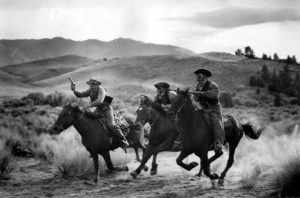 When a crime is committed, it seems to take forever to bring justice for the victims. Sometimes people just don’t want to wait, or they are so mad about the crime committed against them or their family, that they decide, either consciously or unconsciously, to take matters into their own hands. This is known as vigilante justice, and while we still have it today, it really was more prevalent in the Old West….at least as it applies to storming the jail and hanging the “criminal” accused of the crime, without a trial.
When a crime is committed, it seems to take forever to bring justice for the victims. Sometimes people just don’t want to wait, or they are so mad about the crime committed against them or their family, that they decide, either consciously or unconsciously, to take matters into their own hands. This is known as vigilante justice, and while we still have it today, it really was more prevalent in the Old West….at least as it applies to storming the jail and hanging the “criminal” accused of the crime, without a trial.
Vigilante justice was more common in the wild west days because law enforcement was almost non-existent. Vigilantes took it upon themselves to “enforce the law,” as well as their own moral code, even if the event was not necessarily against the law. When a mob would decide that a prisoner is guilty, they would storm the jailhouse, drag the prisoner out, down the street to a big tree, and there they would hang the prisoner, whether they were guilty or not. The mob had decided. I suppose that a lot of times the person who was hanged was guilty of the crime, but without a trial and evidence to prove their guilt, how could anyone be sure?
The term vigilante stems from the its Spanish equivalent, meaning private security agents, but the vigilantes of 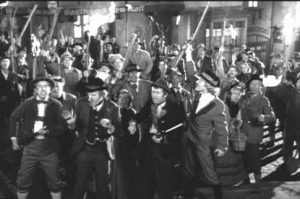 the old west and the mobs, who riot for their idea of right these days, have little in common with security agents. Most vigilantes and mobs are driven anger and adrenaline. Unfortunately those two things together don’t often bring a good outcome, and in the case of lynch mobs, it’s never a good outcome. Old West vigilantes were most common in mining communities, but were also known to exist in cow towns and in farming settlements. These groups usually formed before law and order existed in a new settlement. The justice dished out included whipping and banishment from the town, but more often, offenders were lynched. And sometimes the vigilante groups formed in places where lawmen did exist, but were thought to be weak, intimidated, or corrupt.
the old west and the mobs, who riot for their idea of right these days, have little in common with security agents. Most vigilantes and mobs are driven anger and adrenaline. Unfortunately those two things together don’t often bring a good outcome, and in the case of lynch mobs, it’s never a good outcome. Old West vigilantes were most common in mining communities, but were also known to exist in cow towns and in farming settlements. These groups usually formed before law and order existed in a new settlement. The justice dished out included whipping and banishment from the town, but more often, offenders were lynched. And sometimes the vigilante groups formed in places where lawmen did exist, but were thought to be weak, intimidated, or corrupt.
Some people see vigilantes as heroes, thereby giving them he support of some of the law-abiding citizens. Some people saw them as a necessary step to fill a much needed gap. Nevertheless, sometimes the vigilance committee began to wield too much power and became corrupt themselves. At other times, vigilantes were nothing more than ruthless mobs, attempting to take control away from authorities or masking themselves as “do-gooders” when their intents were little more than ruthless or they had criminal intent on their own minds. One of the first vigilante groups formed was the San Francisco Vigilantes of 1851. After several criminals were hanged the committee was disbanded. When the city administration, itself, became corrupt, a vigilante group formed once again in 1856. There were many vigilante groups formed in the American West. The Montana 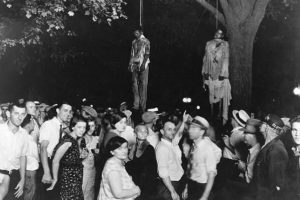 Vigilantes who hanged Bannack Sheriff Henry Plummer in 1864. They controlled the press, so the sheriff was made out to be the leader of an outlaw gang called the Innocents. Further investigation indicates that it might have been the vigilante group, themselves, who were behind the chaos reigning in Montana and that Henry Plummer was an innocent man. Following the Civil War, the Reno Gang began to terrorize the Midwest, resulting in the formation of the Southern Indiana Vigilance Committee. The next time the Reno Gang attempted to rob a train, a the vigilante group lynched its leaders…Frank, William and Simeon Reno. Vigilantes did good in some instances, but it was not really the best form of justice.
Vigilantes who hanged Bannack Sheriff Henry Plummer in 1864. They controlled the press, so the sheriff was made out to be the leader of an outlaw gang called the Innocents. Further investigation indicates that it might have been the vigilante group, themselves, who were behind the chaos reigning in Montana and that Henry Plummer was an innocent man. Following the Civil War, the Reno Gang began to terrorize the Midwest, resulting in the formation of the Southern Indiana Vigilance Committee. The next time the Reno Gang attempted to rob a train, a the vigilante group lynched its leaders…Frank, William and Simeon Reno. Vigilantes did good in some instances, but it was not really the best form of justice.
Karen is my grandson, Chris Petersen’s fiancé, and they are having my first great grandchild, a baby girl, just about any time. Since she was just a little girl, Karen has wanted to be a mommy, so this baby is a dream come true. I have seen Karen with her friends’ babies, and it’s plain to see that Karen is totally in her element with babies. She is going to be an amazing mom. Her sweet disposition and her caring ways really shine when she is caring for and playing with a baby. Her little girl is due on my daughter, Amy Royce’s birthday, but you just never know when these babies will decide to make their appearance. Early or late, we don’t have very long to wait, that’s for sure.
Karen has a great sense of humor, and loves to pull of a good joke or prank, and since she has been around my grandsons, Chris and Josh, her pranks, like theirs, tend to be aimed at the grandma…me. Of course, they are all in good fun, and so nothing to get upset about, but it is plain to see that those boys have corrupted that sweet girl already!! Hahaha!! It’s a good thing for her that Karens/Caryns have to stick together (as she puts it), because if that weren’t the case, I might have to retaliate on some of the pranks she has pulled on me.
Karen has been such a great blessing to my daughter, Corrie Petersen, and her husband, Kevin, who always wanted a daughter, and consider Karen to be the daughter they never had. And to top it off, she is giving them a granddaughter, which they really never expected to have. For Corrie and Kevin, this is a twofold dream come true and they are excited beyond words. For them and for me, we love Karen because of the happiness she has brought to Chris’ life. I have never seen my grandson so happy and fulfilled. For him, there is nothing he wants more that to have a family. He is so ready to be a husband and daddy, and I have been so impressed with him as he prepares for the birth of his little girl, and I attribute much of that to Karen. They have been stashing away a savings for after the baby’s birth, and buying diapers so that when she arrives, Karen can stay home with her for a few months. I am so excited for all the wonderful things that are coming in their future…many good things ahead. Today is Karen’s birthday. Happy birthday Karen!! Have a great day!! We love you!!
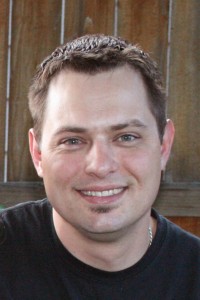 My son-in-law, Travis Royce is a man of many talents, who never brags on himself. He is really a very humble man. He loves do home improvement projects and make things in general. Last year, while his family was visiting us out in Wyoming, Travis was home building a beautiful patio area for Amy at home. Because Travis and Amy like to make wine, Travis wanted to incorporate wine into the design, so he used wine bottles as the spindles on the rail. It is such a cool, and unique idea, a one that is not surprising when Travis makes something. He has really unique ideas, and with his tendency to try to surprise people with his work, Travis is a man with a flair for the unexpected.
My son-in-law, Travis Royce is a man of many talents, who never brags on himself. He is really a very humble man. He loves do home improvement projects and make things in general. Last year, while his family was visiting us out in Wyoming, Travis was home building a beautiful patio area for Amy at home. Because Travis and Amy like to make wine, Travis wanted to incorporate wine into the design, so he used wine bottles as the spindles on the rail. It is such a cool, and unique idea, a one that is not surprising when Travis makes something. He has really unique ideas, and with his tendency to try to surprise people with his work, Travis is a man with a flair for the unexpected.
According to my granddaughter, Shai Royce, her dad “loves home improvement projects, reading, especially about history, comedy, Kung Foo, football, playing guitar, and the three of us.” The three of them being his family, my daughter, Amy, and their kids, Shai and Caalab. Most of Travis’ likes were things I knew about, but Kung Foo surprised me. Not sure what to make of that, I asked Shai is he was taking classes in Kung Foo, but she said no, almost laughing I’m sure, it’s Kung Foo movies he likes. In fact, he and Shai used to watch Kung Foo movies together when she was a little girl. Travis loves to barbecue and entertain. He is a great cook, often cooking breakfast for his family, but he is really in his element when he is barbecuing. He loves making wine to share with his family and friends, and what better time to share wine than when you have friends over to barbecue. With Travis sense of humor, it’s always great time. 
The past couple of years, Travis has stepped out of his element to a degree, when the whole family decided to bowl on a bowling league. It was a lot of fun for all of them this year, and they were more than a little bit surprised to find that they had taken fist place. They have been invited to bowl in a county wide tournament for the county championship in Bellingham this Saturday and they are looking forward to that. Then, they found out that Travis had taken most improved bowler award…improving his average by 13 pins. I’d say that it has been a pretty good year for Travis, and we wish him many more great years in the future. Today is Travis’ birthday. Happy birthday Travis!! Have a great day! We love you!!
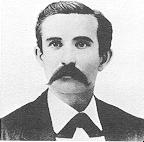 For many years I was essentially unaware of the Texas Rangers. Then, with the show Walker, Texas Ranger, this elite group of law enforcement officers became a household word. Of course, the Texas Rangers have been an institution in Texan since they were unofficially created by Stephen F. Austin in a call-to-arms written in 1823. They were first headed by Captain Morris. After a decade, on August 10, 1835, Daniel Parker introduced a resolution to the Permanent Council creating a body of rangers to protect the border, something we continue to need today.
For many years I was essentially unaware of the Texas Rangers. Then, with the show Walker, Texas Ranger, this elite group of law enforcement officers became a household word. Of course, the Texas Rangers have been an institution in Texan since they were unofficially created by Stephen F. Austin in a call-to-arms written in 1823. They were first headed by Captain Morris. After a decade, on August 10, 1835, Daniel Parker introduced a resolution to the Permanent Council creating a body of rangers to protect the border, something we continue to need today.
On May 2, 1874, John B. Jones began his adventurous career as a lawman, when he was appointed as a major in the Texas Rangers. Jones was born in Fairfield District, South Carolina, in 1834. He moved to Texas with his father when he was a small boy. He went to college at Mount Zion College in South Carolina, and after graduating he returned to his home in Texas to enlist in the Confederate Army during the Civil War. Talented and ambitious, he eventually rose to the rank of adjutant general. Jones took the defeat of the Confederacy hard, and after the war, he spent some time traveling in Mexico and Brazil trying to establish a colony for other disgruntled former Confederates. After determining that the colonial schemes held little promise for success, he returned to Texas where his military experience won him his major’s commission with the Texas Rangers.
Jones commanded the Frontier Battalion, a force of about 500 men stationed along the Texas frontier from the Red River to the Rio Grande. His mission was two-fold: to keep hostile-border Indians out of Texas and control the outlaws within Texas. His first Indian fight came less than six weeks later. While patrolling near Jacksboro, Texas, with 28 men, Jones spotted a band of more than 100 Indians that he thought were hostile Kiowa, Commanche, and Apache. Displaying more courage than wisdom, Jones directed his small band to attack the larger force of Indians. In the ensuing battle, two of the Rangers were killed and two wounded, but they were lucky to escape without more serious losses. Jones, feeling quite chastened, acted with greater care in his subsequent battles with Indians. Soon, his force became highly effective in repulsing invasions.
Four years later, Jones took on one of the most notorious outlaws on the Texas frontier…a man named Sam Bass. For some months, Bass and his gang had been staging train robberies in Texas. Although most of the robberies failed to net much money because Bass and his partners were incompetent amateurs. Nevertheless, the people of Texas demanded that Bass be stopped. The Texas government turned to Jones, ordering him to 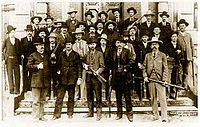 use his Rangers to run Bass down. Seizing on the drama of the chase, the press dubbed the affair the “Bass War.” For four months, Bass led Jones and his Rangers on a wild chase through Texas. In July 1878, Jones learned that Bass was planning to rob the bank in Round Rock, Texas. When Bass did hit the bank, Jones and his Rangers were waiting. Bass was badly wounded in the ensuing gun battle, and he died several days later. Oddly it was Bass who later became a legend, portrayed as good-natured Robin Hood, while Jones has largely been forgotten. Jones continued to command the Frontier Battalion until he died of natural causes in 1881 at the age of 46.
use his Rangers to run Bass down. Seizing on the drama of the chase, the press dubbed the affair the “Bass War.” For four months, Bass led Jones and his Rangers on a wild chase through Texas. In July 1878, Jones learned that Bass was planning to rob the bank in Round Rock, Texas. When Bass did hit the bank, Jones and his Rangers were waiting. Bass was badly wounded in the ensuing gun battle, and he died several days later. Oddly it was Bass who later became a legend, portrayed as good-natured Robin Hood, while Jones has largely been forgotten. Jones continued to command the Frontier Battalion until he died of natural causes in 1881 at the age of 46.
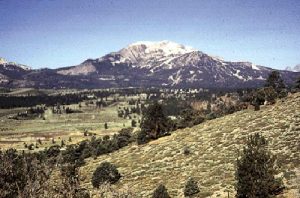 During the gold rush years, in 1857, to be exact, two German men who had been traveling with a wagon train headed to California, decided to leave the rest of the group and headed out on their own. They wound up in the Mono Lake region of northern California. One of the men would later describe the area as “the burnt country.” While crossing the Sierra Nevada near the headwaters of the Owens River, they sat down to rest near a stream. Looking around, they noticed a curious looking rock ledge of red lava filled with what appeared to be pure lumps of gold “cemented” together. That was how their “mine” got its name.
During the gold rush years, in 1857, to be exact, two German men who had been traveling with a wagon train headed to California, decided to leave the rest of the group and headed out on their own. They wound up in the Mono Lake region of northern California. One of the men would later describe the area as “the burnt country.” While crossing the Sierra Nevada near the headwaters of the Owens River, they sat down to rest near a stream. Looking around, they noticed a curious looking rock ledge of red lava filled with what appeared to be pure lumps of gold “cemented” together. That was how their “mine” got its name.
The ledge of that hillside was literally loaded with the ore. The excited men couldn’t believe their eyes. One of the men was laughing at the other as he pounded away about ten pounds of the ore to take with him…because he did not believe it was really gold. The man who believe that it was gold drew a map to the location and the two men continued their journey. Along the way, the disbeliever died and since he was laden with so much ore, the believer tossed the majority of the samples. Then, after crossing the mountains, he followed the San Joaquin River to the mining camp of Millerton, California. After a long, weary journey, the German had become ill and soon went to San Francisco for treatment. He was diagnosed and cared for by a Doctor Randall who told the man he was terminally ill with consumption (tuberculosis). With no money to pay the doctor and too ill to return to the treasure, he paid his caretaker with the ore, the map he had drawn, and provided him with a detailed description.
Doctor Randall shared this knowledge with a few of his friends and together they decided to go for the gold. They arrived at old Monoville in the spring of 1861. After enlisting additional men to help, Randall’s group began to prospect on a quarter-section of land called Pumice Flat. Their claim is thought to have been some eight miles north of Mammoth Canyon…the 120 acres were near what became known as Whiteman’s Camp. Word of possibly a huge cache of gold spread quickly and before long miners flooded the area hunting for the gold laden red “cement.” One story tells that two of Doctor Randall’s party had in fact found the “Cement Mine,” taking several thousand dollars from the ledge. Unfortunately, for those two men, the area was filled with the Owens Valley Indian War which began in 1861. The Paiute Indians, who had heretofore been generally peaceful, were angered at the large numbers of prospectors who had invaded their lands. The two miners who 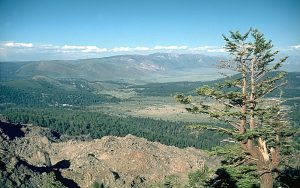 had allegedly found the lost ledge were killed by the Indians before they were able to tell of its location.
had allegedly found the lost ledge were killed by the Indians before they were able to tell of its location.
Though the “cement” outcropping was never found again, the many prospectors who flooded the eastern Sierra region did find gold. Apparently there was a huge cache there after all. This resulted in the mining camps of Dogtown, Mammoth City, Lundy Canyon, Bodie, and many others. The lost lode is said to lie somewhere in the dense woods near the Sierra Mountain headwaters of the San Joaquin River’s middle fork. If it really exists, it must be very well hidden.

